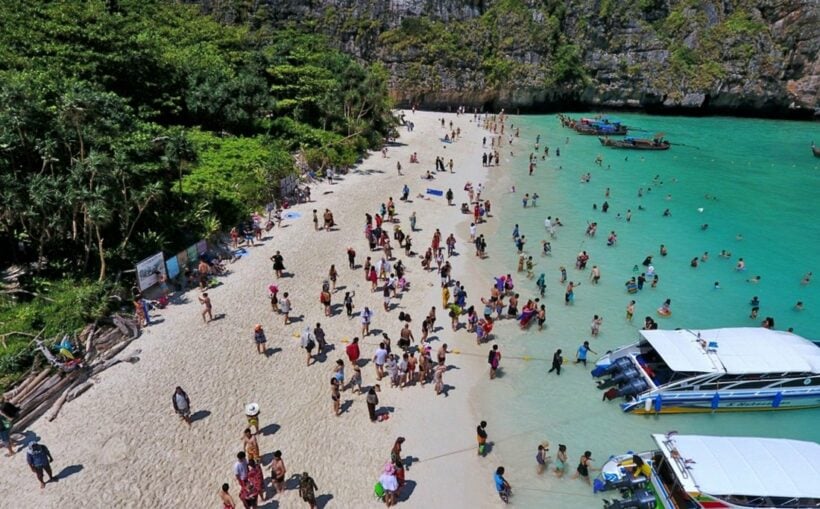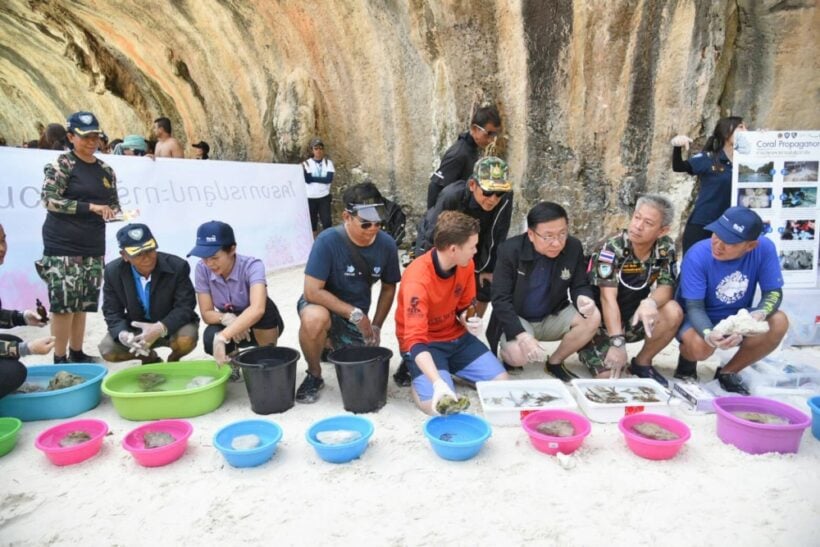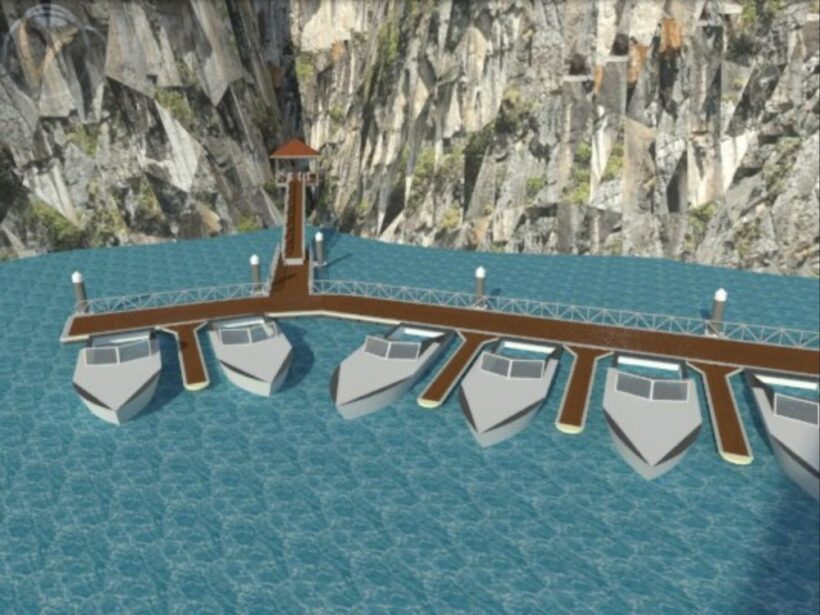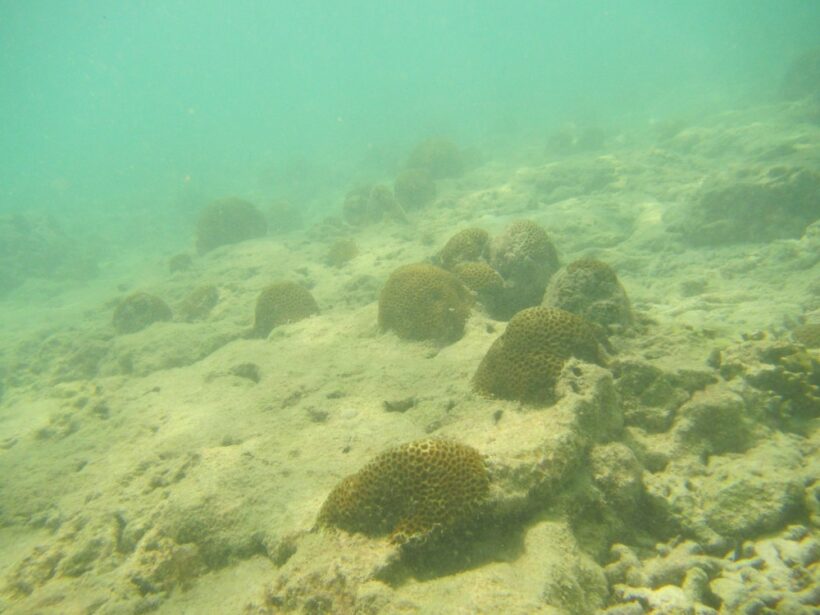Maya Bay – let the healing begin

By Piyaporn Wongruang – The Sunday Nation
It was around 10 in the morning. There was peace and tranquility at Maya Bay and its beach with just a few speedboats docking in front of the bay. The crystal clear deep blue turquoise sea water filled the vision of Plianprasop Khaonual, a long-time park ranger and among the first who explored the bay’s potential after the Hollywood film, the Beach, was shot here, and rocketed the bay to worldwide fame since 2000.
Within another half an hour, the crystal clear waters were dotted with an increasing number of speedboats transporting tourists to the bay. Soon the place was crowded with tourists, mostly foreigners, jumping off the boats and roaming the 3-rai (0.48-hectare) beachfront.
“It has changed a lot and degraded extensively,” said Plianprasop.
Maya Bay is the tourist magnet of Had Nopparat Tara-Mu Ko Phi Phi National Park. Portrayed as a remote location, the hideaway of a young backpacker Richard, starring Hollywood star Leonardo Di Caprio, Maya Bay has been trampled on by tourists non-stop for nearly 20 years. Its ecosystem has become degraded, prompting a wake-up call for concerned authorities to take a serious look at the impact of tourism there.
The National Parks, Wildlife, and Plant Conservation Department, which oversees national parks nationwide, eventually decided to close the bay to pave the way for rehabilitation and to start a major face-lift for tourism there.

The agreement
For more than two years, Wutthisak Thongkerd, a business operator and a chairman of the two-year-old Phitak Phi Phi (Protecting Phi Phi) group, has felt the pinch of tourism’s impact on the bay and other tourist locations nearby.
The group, comprising business operators and community members of Phi Phi island, decided to discuss and gather views on the issue. In consultation with the park advisory committee, of which Wutthisak is also a member, the group decided to forward their consensus decision to close the bay to the park and the department for consideration.
In consultation with the marine resources and national parks advisory committee, the National Parks Department decided to issue an order to close the bay from June 1 to September 30 to make way for rehabilitation and a face-lift for tourism that is expected to serve as a model for other marine parks faced with a similar burden.
“The bay needs some rest,” said Wutthisak. “Tourism brings positive things, but also negative ones. If we don’t limit the activity, it would cause damage beyond repair. Our income would be affected a little bit, but we rather wish to have income generated in the long term, not ruined for ever.”
Tourism waves
Being probably Thailand’s most popular marine spot, Maya receives as many as 4,000 tourists and around 200 boats a day, and most ecologists agree those numbers are beyond the bay’s capacity to accommodate.
This year, it is expected that around 5 million tourists would visit Maya and the park, as well as the other two marine parks nearby – Similan and the Ao Phang-nga.
Still, tourism is a key driver of the country’s economic growth as seen in the latest 20-year national strategy, with income generated from the sector accounting for 20 per cent of the country’s GDP, according to Thon Thamrongnawasawat, a marine ecologist, and a member of the national strategy committee on sustainable growth, and of the national reform committee on the environment and natural resources.
This year, tourism is expected to bring in around Bt3.3 trillion and 40 million tourists, 80 per cent of whom would visit popular marine parks, Thon noted, suggesting the impacts that can be projected.
As the impacts on Maya have been felt, concerned parties have reached a consensus to curb tourism impacts on Thai marine parks. Maya is the first to undergo a radical facelift, an action Thon called a big bang.

Wounds
Plianprasop managed to make his way through the crowd and walked deeper into the island of 18 rai. There he saw the beach forest degraded, with the roots of several trees left exposed, due to excessive strolls over the sandy floor. The floor and the beach have become packed due to excessive access to the fragile ecosystems, but what is more worrying is the damage done to coral reefs under the water.
According to a recent survey by the department’s Marine National Parks Operation Centre 3, the reef flats extending over nearly 30 rai of the 59 rai of the bay have become seriously degraded, while the reef edge has been moderately degraded. Broken corals and fragments were found extensively on the sea floor.
Tourist boats passing in and out the bay were largely to blame for the damage as they gathered sand from the beaches and dropped them over the corals while moving, causing their destruction. The boat anchors were also responsible for damaged corals when they were dropped into the sea to help dock the boats.
“All the problems follow tourism activities here, which have been aggravated by the growing number of tourists. If we don’t stop and start rehabilitating the place, I’m afraid that its tourism potential |would collapse,” said Jongklai Worapongsathorn, the department’s deputy chief.
Healing
At the beach front, the Marine National Parks Operation Centre 3 head, Supaporn Prempree, is busy instructing her staff to replant corals expected to be returned to the sea off Maya once they become strong enough.
One after another, tips of branches of broken corals collected from the bay and nearby are cut off before being attached to rocks so that they would grow on them later.
Coral propagation is the first and foremost rehabilitation task taken up ahead of schedule. It’s expected that by the end of the bay closure in September, at least 2,000 coral tips would be replanted and regrown in Maya’s waters.
The department’s National Parks Office director, Songtham Suksawang, said other ecosystems of the bay including the beach forest would be studied to help address the impacts as well as find solutions.
Last but not least is a new tourism management approach for the bay. The department has currently hired some universities to help study the carrying capacity of the bay. It’s roughly calculated that 2,000 tourists and 100 boats a day is all that the bay can take.
To curb the impacts to tourism, access to the bay would be shifted to the back of the island, where a new aluminium and quality plastic-based pier and bridge would be built. Tourist numbers and transport boats will also be cut to half of the present figure if confirmed by the study, while an e-ticketing system will be introduced to help handle tourist demand.
Through the new approach, the place will have a greater chance to withstand the impacts, while pressure from tourism would be better managed by moving tourists to less-crowded spots, or second-tier destinations.
“Today, if we don’t close the bay and rehabilitate it, the damage would become irreparable in the future,” said Songtham.
As a marine ecologist and reformer, Thon has lauded the department’s action and said it marked a starting point for reform on marine resources management in the country.
“The action is like a big bang. This is a turning point. We are saying we will prioritise the health of our environment and natural resources ahead of income. This is reform,” said Thon.

At the beach front, the Marine National Parks Operation Centre 3’s head, Supaporn Prempree was busy instructing her staff on the technique of replanting corals to be returned to the sea off Maya Bay once they become strong enough.
It’s a coral propagation technique commonly applied to reintroduce damaged corals back to the sea.
Broken pieces of live coral were collected from the front of the bay and nearby, along with rocks that will provide the base for the replanted corals. The coral pieces are kept covered in seawater to keep them alive.
Tips are then cut off from branches of broken coral, and the tips attached by glue to the rocks, awaiting a spurt of growth. A few drops of catalyst are required to help solidify the attachment process and protect against disease.
One rock can carry two to three coral tips. The rocks are then tagged and sent to a nursery ground at the front of the bay. There they will be checked weekly for parasites and diseases, and isolated if found to be infected.
Only those free of any diseases will be returned to their grounds. “We plan to reintroduce at least 2,000 coral tips to Maya in the next four months,” said Supaporn. “We’re hopeful.”

STORY: The Nation
Latest Thailand News
Follow The Thaiger on Google News:


























